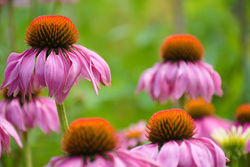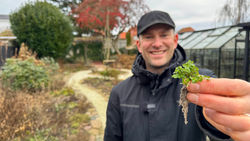Is it OK to plant invasive plants in your garden?
- Lars Wildes
- Dec 6, 2022
- 5 min read
Updated: May 14, 2023
This is a question that I get asked all of the time.
I post one photo of a lupine (Lupinus) and get a million DMs telling me how invasive the plant is for Denmark, and how I’m destroying the country.
Maybe that’s a bit dramatic. But that’s what the subject of ‘invasive’ and ‘non-native’ plants can do to gardeners.
If you’re like me, you’ve asked yourself the question “Is it ever OK to plant non-native plants?” before. Especially when you see a gorgeous, colorful plant that would look perfect in your flowerbed.
Am I right?
What I can tell you is this — I’m a huge fan of promoting biodiversity and celebrating plants native to Denmark. And I think that everyone should do the same.
But are all non-native plants “invasive” and “bad”?
I don’t think so. Many non-native plants do a better job of attracting (and feeding) pollinators like bees and butterflies than native plants.
And yet there are plants that take away space and resources for native plants.
Let’s take a closer look at native versus non-native plants to help you decide for yourself.

What are native plants?
This is the easy one. Native plants can trace their origins back to the area in which you find them.
For a small country like Denmark, this is a pretty easy list to understand. But when you consider that we share a land border with Germany… and a border with Sweden and Norway, this distinction gets a little tricky.
It’s a problem for any country or region. Trying to figure out the native plants of Georgia (where my in-laws live) compared to the native plants of North America isn’t easy.
In some way, we’ll never truly know where a plant originally came from… not without deep research. We can, however, follow best practices and focus on plants that are known to have originated in our areas.
And this matters.
When we lived in Cape Town, South Africa, the city was going through a terrible drought. I had to totally reconsider what I could have in my garden.
I started only choosing water-wise plants that were native to the area. These were equipped to handle the harsh, dry conditions… and they still looked gorgeous.
Even here in Denmark, there’s a nation-wide movement towards going back to the wild. Roadsides and empty spaces are being left untamed and nature is free to grow what it wants.
The result is that more bees, insects and butterflies are returning to areas where they were once unwelcome. And with that, you get more birds, etc. The ripple effect is real.
What are non-native plants?
Non-native plants are plants and flowers that do not have origins in the geographic area in question.
But this doesn't mean that they are invasive or ‘bad’ for that area.
Some non-native plants have become naturalized. Basically, a naturalized non-native plant doesn’t cause harm to its ecosystem or the biodiversity of the area.
What are invasive plants?
Invasive plants are plants that came to an area, naturalized quickly and are now destroying other plants.
A prime example of an invasive plant is the notorious Kudzu (Pueraria lobata) that you see everywhere in the southern United States.
It was introduced during the latter half of the 19th century and reproduced crazy fast. It grows so quickly that it kills off the local plants.
The real problem with invasive plants is that they have the power to hurt the biodiversity of an area. If a native plant can’t compete, then the insects, creatures and pollinators that depend on that plant can’t survive.
When insects and animals start to die off. That’s an irreversible loss. And a potentially dangerous one.
Is It OK to plant and grow non-native plants?
Here’s the thing. I can’t tell you what to do. It’s your garden and you have the incredible responsibility to be a part of the creation process.
What I can do is tell you that you shouldn’t forget the beauty (and ease) of growing and planting native plants.
Do your homework and look at what is native to your area. Maybe there’s something you didn’t even know existed?
And if you want your garden to be enjoyed and truly loved by insects and pollinators, then native species are the best.
That’s backed by research, too.
A study in the US discovered that caterpillar and bird populations were higher in urban gardens with predominantly native planting compared to gardens dominated by non-native planting. The increase in birds is because they feed on caterpillars and those little guys feed better on native plants.
When is it OK to grow and plant non-native flowers?
Non-native plants are most often a problem in the wild.
In your garden, where you’ll take care of them, they can be used to bring color and texture to your space.
In my garden, flowers like Lupines are taken care of, while plants native to Denmark are still grown and encouraged.
While flowers like Lupines are not native to this area, they act as magnets for large populations of bumblebees, which can increase the number of pollinator visits to native plants and have a positive effect on the bees’ life cycle.
The deep roots also help regulate the nitrogen content and enrich the soil around them… which is better for native species, too.
The real concern is when they grow in the wild. There, they can crowd out dandelions, for example.
For me, I collect all of the seeds before they scatter. This is one more way to make sure that I’m not a part of spreading Lupines into the wild, free areas of Denmark.

What are the cons of growing and planting non-native flowers?
The biggest reason to avoid non-native plants is that they can take up too much space and starve native plants and flowers of resources like water and sunlight.
Even if you keep an eye on the seeds that a plant tosses, its root system could be so large that it strangles neighboring plants.
How to grow invasive and non-native plants
If you’ve found a plant that you just can’t live without… and it happens to be a non-native plant. Don’t worry. There is a way where you can enjoy it without risking a total global meltdown.
Invasive plants can be kept in check very easily by growing them in individual pots or containers.
Container gardening for non-native plants and flowers can be done either by:
Planting individual flowers and plants into pots and containers above ground
Burying the container underground. Simply dig a hole large enough for the container to fit. Leave the lip of the pot sticking out of the ground. Fill it with gravel and soil and plant away.
Whatever you decide, be sure to use a pot that is at least 1-2 sizes larger than what the plant came in. The container will help keep the non-native (or invasive) plant’s roots in check and make sure that it doesn’t get out of hand.
If you have a flowering plant, do your ecosystem a favor and collect the seeds before they scatter.
As gardeners, we have the incredible responsibility to be caretakers for the planet.
We can't just put plants and flowers into ‘good’ and ‘bad’ boxes. It’s way more nuanced than that.
Be sure to do your research and talk to local gardeners (or drop me a line!).
Whatever you do, make sure that the garden you plant brings joy to you and the planet… that includes the little creatures who are also waiting for your flowers to grow.






Comentarios